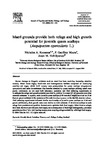Maerl grounds provide both refuge and high growth potential for juvenile queen scallops (Aequipecten opercularis L.)
| dc.contributor.author | Kamenos, NA | |
| dc.contributor.author | Moore, PG | |
| dc.contributor.author | Hall-Spencer, Jason | |
| dc.date.accessioned | 2013-02-22T18:36:29Z | |
| dc.date.available | 2013-02-22T18:36:29Z | |
| dc.date.issued | 2004-01-01 | |
| dc.identifier.issn | 0022-0981 | |
| dc.identifier.issn | 1879-1697 | |
| dc.identifier.uri | http://hdl.handle.net/10026.1/1412 | |
| dc.description.abstract |
Human damage to biogenic substrata such as maerl has been receiving increasing attention recently. Maerl forms highly biodiverse and heterogeneous habitats composed of loose-lying coralline red algae, which fulfil nursery area prerequisites for queen scallops (Aequipecten opercularis) and other invertebrates. The benefits obtained by queen scallops utilising maerl were poorly understood, so we used both laboratory predation and field tethering experiments to investigate the refuge and growth potential provided by pristine live maerl (PLM) grounds over other common substrata. In aquaria, more juvenile queen scallops (<35 mm shell height) survived on PLM than on gravel substrata in the presence of the crab Carcinus maenas or the starfish Asterias rubens. Field tethering experiments indicated similar survivorship of juvenile queen scallops on PLM than gravel; additionally, their growth rates were similar on both substrata. PLM allows scallops to seek refuge from predators and position themselves to optimise their food supply. Other bivalve refugia have been shown to provide poor food supply as a consequence of their high heterogeneity, yet maerl grounds provide a 'win-win' scallop nursery area coupling refuge availability with high food supply. © 2004 Elsevier B.V. All rights reserved. | |
| dc.format.extent | 241-254 | |
| dc.language | en | |
| dc.language.iso | en | |
| dc.publisher | Elsevier BV | |
| dc.subject | growth | |
| dc.subject | maerl | |
| dc.subject | predation | |
| dc.subject | 'nursery area' | |
| dc.subject | refuge | |
| dc.subject | scallop | |
| dc.subject | Scotland | |
| dc.title | Maerl grounds provide both refuge and high growth potential for juvenile queen scallops (Aequipecten opercularis L.) | |
| dc.type | journal-article | |
| dc.type | Journal Article | |
| plymouth.author-url | https://www.webofscience.com/api/gateway?GWVersion=2&SrcApp=PARTNER_APP&SrcAuth=LinksAMR&KeyUT=WOS:000225376300003&DestLinkType=FullRecord&DestApp=ALL_WOS&UsrCustomerID=11bb513d99f797142bcfeffcc58ea008 | |
| plymouth.issue | 2 | |
| plymouth.volume | 313 | |
| plymouth.publication-status | Published | |
| plymouth.journal | Journal of Experimental Marine Biology and Ecology | |
| dc.identifier.doi | 10.1016/j.jembe.2004.08.007 | |
| plymouth.organisational-group | /Plymouth | |
| plymouth.organisational-group | /Plymouth/Faculty of Science and Engineering | |
| plymouth.organisational-group | /Plymouth/Faculty of Science and Engineering/School of Biological and Marine Sciences | |
| plymouth.organisational-group | /Plymouth/PRIMaRE Publications | |
| plymouth.organisational-group | /Plymouth/REF 2021 Researchers by UoA | |
| plymouth.organisational-group | /Plymouth/REF 2021 Researchers by UoA/UoA07 Earth Systems and Environmental Sciences | |
| plymouth.organisational-group | /Plymouth/Research Groups | |
| plymouth.organisational-group | /Plymouth/Research Groups/Marine Institute | |
| plymouth.organisational-group | /Plymouth/Users by role | |
| plymouth.organisational-group | /Plymouth/Users by role/Academics | |
| dc.identifier.eissn | 1879-1697 | |
| dc.rights.embargoperiod | Not known | |
| rioxxterms.versionofrecord | 10.1016/j.jembe.2004.08.007 | |
| rioxxterms.licenseref.uri | http://www.rioxx.net/licenses/all-rights-reserved | |
| rioxxterms.type | Journal Article/Review |


